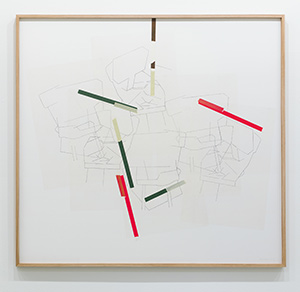
Noli me tangere III, 2012
Noli me tangere III, 2012
Graphite, paper, adhesive tape and paint on paper
152 x 165 cm
Collection of the artist
© VEGAP, Bilbao, 2017
Pello Irazu (Andoain, 1963) has made numerous drawings throughout his career. His drawings are not preliminary studies or sketches for his sculptures, but complete works of art in themselves. They are usually exhibited together with his sculptures, both elements being treated as equivalent and inseparable. [1] The drawings originate from schematic everyday scenes or objects (such as faces or objects) that the artist makes into an abstraction. [2] To Irazu, these drawings aren’t “a sculptor’s drawings”, but are themselves “sculptures” [3] that he calls “wall sculptures” or “spatial screens.” [4] Through the application of certain techniques of sculpture to drawing, they retain a sculptural quality; in them, Irazu addresses the the problems that arise in the multiple relations between our bodies, objects, images, and spaces.. [5]
In Noli me tangere III, as in other drawings from this period, Irazu integrates various materials into a single work, and in doing so, he can allude to different languages. [6] In addition to graphite, he uses adhesive tape to mark the construction of the created forms, and to emphasize more effectively the projected spatiality of the work. [7] The adhesive tape is applied directly on the paper, and the artist paints it in different colors. The strips of tape indicate the construction of forms, though without relinquishing neither their simultaneous condition as “bars” of color nor the tension of the gesture registered in each brushstroke. [8] In short, the pieces of adhesive tape in Noli me tangere III fulfill a dual function: they re-draw the forms and also give texture to the final composition. [9]Furthermore, as it is used in this case, the adhesive tape is present within various material layers, one placed on top of the other: the paper ground is laid with a mazelike weave of bits of paper drawn in graphite, onto which painted strips of adhesive tape are placed. [10]
In Noli me tangere III, Irazu reproduces the profile and basic volume, from different viewpoints, of one of his favorite subjects: the chair-sculpture. The artist transforms an ordinary object—the chair—and reconstructs it, to make it generate a sense of strangeness and lose its original function. The modified chair, devoid of functionality, produces a feeling of displacement. We look at something that is recognizable and ordinary, yet at the same time odd. Irazu uses his own photographs of the process of making the chair-sculptures as a source, and he carries his experimentation with the various forms over to the paper. Thus, he creates an indecipherable map in which the true reference is lost, and which only takes on meaning as a mass of volume created by the lines drawn in black on white. [11]
Preguntas
Look at and describe Noli me tangere III (2012). What can you see? Can you explain the forms that Irazu has drawn? What do they remind you of?
In this work, in addition to drawing with graphite, the artist uses bits of paper and adhesive tape, which he sticks to the paper ground. Why do you think he uses material in this manner? What effect does he wish to achieve? Do you think that he achieves his objective? Why?
Once he has placed the tape in the work, Irazu paints it. How would the final result change if he had painted directly on the paper and not on the tape? How would it be different?
Irazu calls his drawings “wall sculptures”. Why do you think that he calls them that? In what ways do you think drawing and sculpture are related? Do you think that he is successful in creating “wall sculptures”? In what way is he able to do so?
Look at other works in the exhibition, such as Switch (1997) and Shadow (Sombra, 2002). How do they relate to Noli me tangere III? How are they similar, and how are the three of them different? Many of these pieces, in which Irazu has used chairs or other everyday objects and materials from his surroundings, emerged during the creation of other works[12]. Has it ever happened to you that, while you were making a drawing or sketch, an idea for something else came up? What would you normally do to save this new idea?
